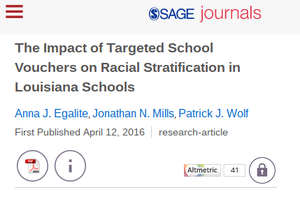A new report by Halley Potter at The Century Foundation asks, “Do Private School Vouchers Pose a Threat to Integration?” Greg Forster has already addressed what he terms “scaremongering” by the report, such as Potter’s speculation that “vouchers have a greater potential for increasing segregation in public schools than for increasing integration.” Forster suggests it is surely preferable to examine how this actually plays out in real life than to speculate on potential outcomes.
 I have concerns with the latter half of the report, which focuses on two empirical studies that use student-level data to ascertain the impact of voucher programs on school integration in Louisiana and Milwaukee. As the lead author of the 2017 Louisiana study referenced in this report, I must address Potter’s misrepresentation of our research.
I have concerns with the latter half of the report, which focuses on two empirical studies that use student-level data to ascertain the impact of voucher programs on school integration in Louisiana and Milwaukee. As the lead author of the 2017 Louisiana study referenced in this report, I must address Potter’s misrepresentation of our research.
The bottom line take-away from our analysis is that 82% of student transfers made possible by the Louisiana Scholarship Program reduced racial stratification in the voucher students’ former public schools, a clear win for desegregation efforts in the state of Louisiana. For context, the reader should note that at the time we conducted this analysis, 34 public school districts in the Pelican State were still under desegregation orders from the federal government, with no indication of when they might finally achieve “unitary” status. Desegregation of its public schools is a problem that Louisiana has struggled to solve for decades. Our analysis provides evidence that this education policy actually reduced racial stratification in the public schools. (For an excellent summary of our findings, see Hayley Glatter’s Feb 2017 article in The Atlantic).
Throughout the peer-reviewed article, however, we also highlight that only 45% of transfers reduced racial stratification in the private schools they attended, a disappointing finding but one that we hope will lead to productive policy conversations.
Potter cannot refute our findings, so she seeks to obfuscate them by carefully merging categories so as to define a “tie” as a loss. This allows her to say that “two-thirds of school transfers in the Louisiana Scholarship Program […] increased segregation in private schools, public schools, or both sectors.” To be clear, a mixed finding is one in which segregation might have been increased in one sector but decreased in another. Reasonable people will disagree about whether to classify a mixed finding like this as a net win or net loss. For instance, it is equally true and consistent with Potter’s re-categorization of our findings to say that “The vast majority (91%) of school transfers in the Louisiana Scholarship Program improved integration in one or both sectors.” Even Potter’s clever wordsmithing can’t hide the fact that only 9 percent of transfers reduced integration in both sectors.
Covering Potter’s analysis of our study earlier this month, Aria Bendix reports, “After crunching the numbers herself, using metropolitan demographics as a benchmark for integration, Potter’s results were quite different.” It’s unclear to me what original number crunching Potter has conducted. Yes, the statistics Potter presents do use metropolitan demographics as a benchmark, but my colleagues and I were the ones to conduct these analyses. Potter’s numbers are taken straight from our study’s appendix, which we provided to ensure complete transparency. Potter provides no new analysis, merely a tactical reorganization of findings that were already available in the published article.
In general, Potter criticizes our decision to present the effects of voucher transfers on public and private schools separately, characterizing this decision as “misleading.” In reality, this was the most transparent and informative way to present the findings. Take for example, the case of a single student transfer in which a student leaves a public school in which their race is over-represented (thus reducing public-school segregation), and arrives in a private school in which their race is also over-represented (thus increasing private-school segregation). Is this a win or a loss? We don’t impose a value judgment on that situation, but leave it to the reader to determine.
How did the Louisiana Scholarship Program affect integration? If I were to take the same liberties as Potter, I could tell you that 91 percent of all voucher transfers reduced segregation in one or both sectors. This is a true statement, but it would be irresponsible to follow Potter’s lead and so bluntly summarize a nuanced set of results, so let me summarize it this way: A third of all voucher transfers resulted in more integrated public and private schools, an additional 57 percent of transfers had mixed effects (positive effects in one sector, negative effects in another), and just 9 percent of transfers had negative effects. The public deserves an accurate, thorough, and transparent reporting of the facts, not careful wordsmithing and clever reorganization of categories to suit an agenda.
— Anna J. Egalite
Anna Egalite is an Assistant Professor in the Department of Educational Leadership, Policy, and Human Development at North Carolina State University.


